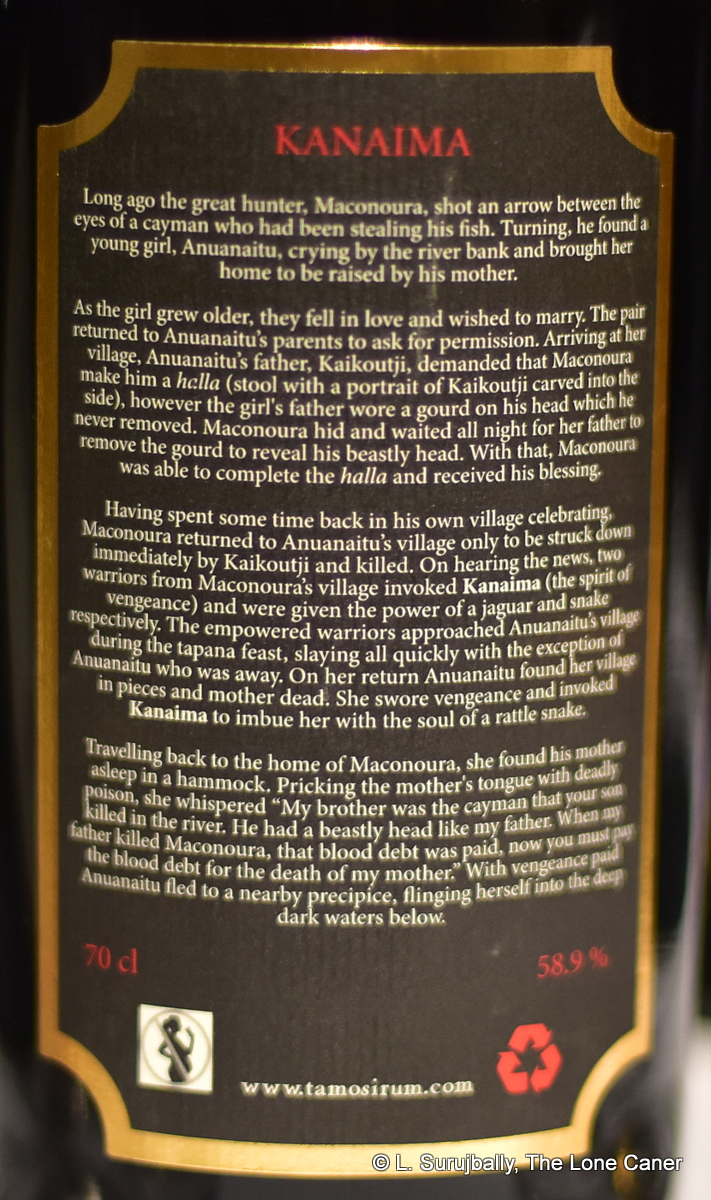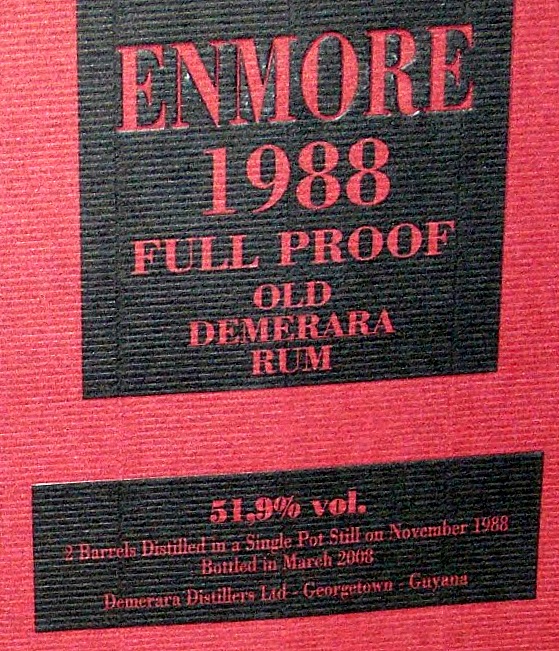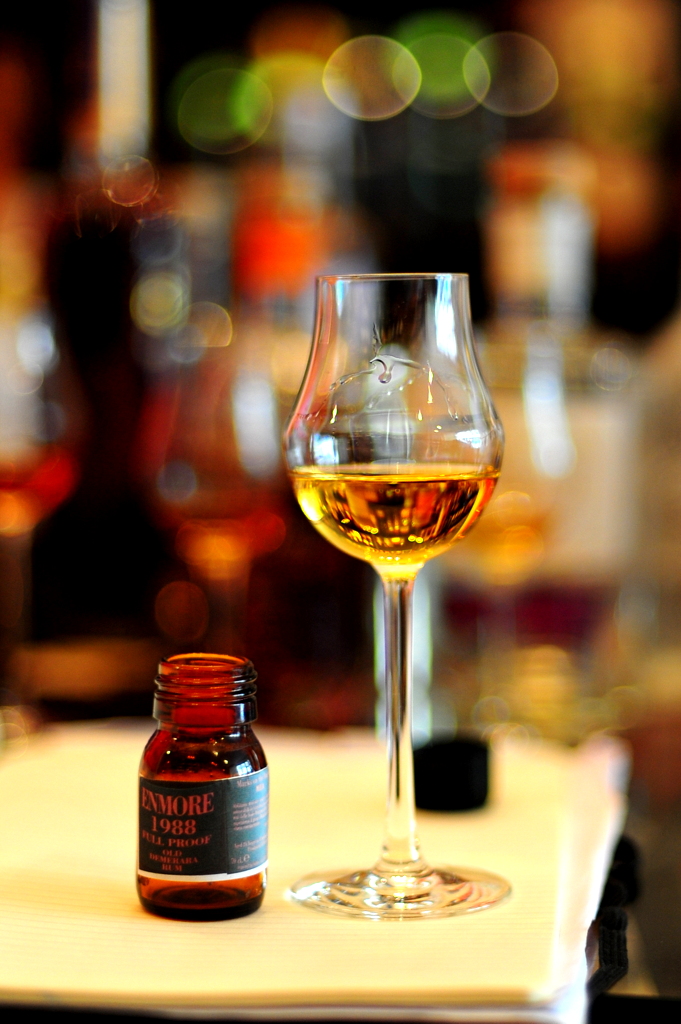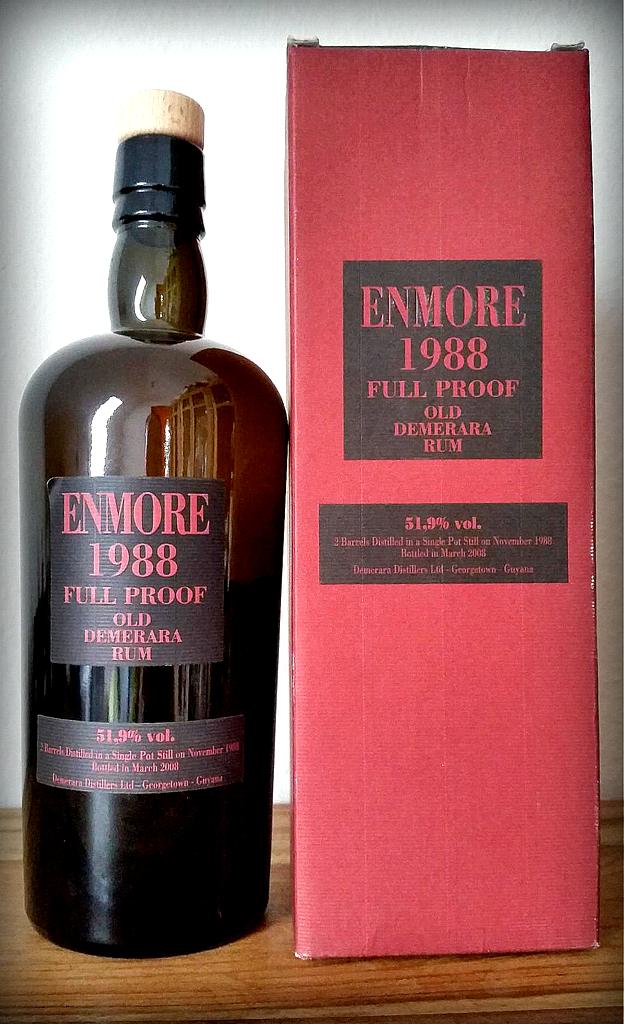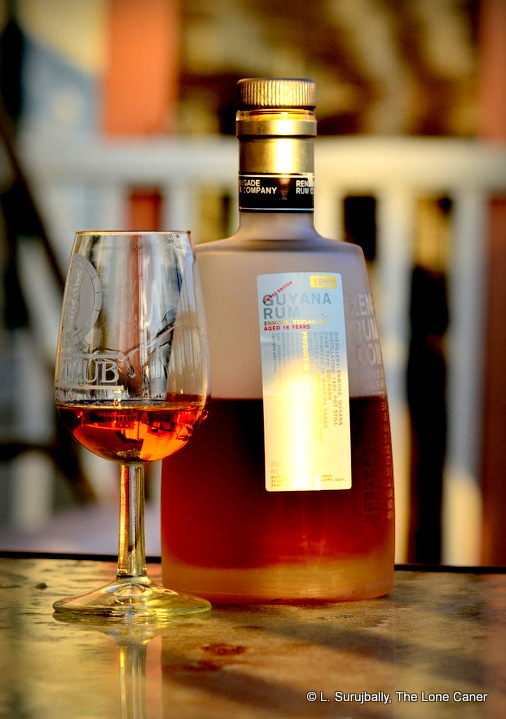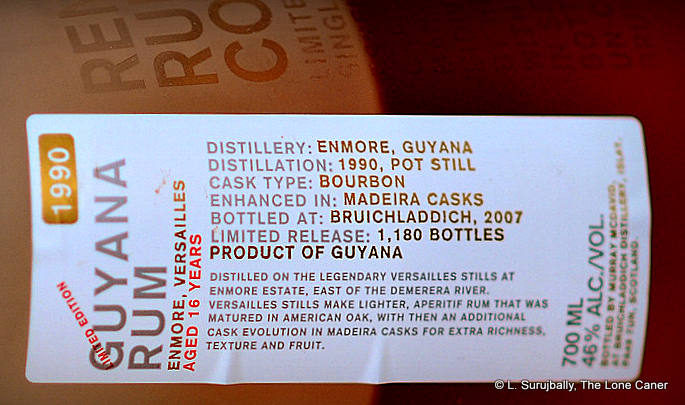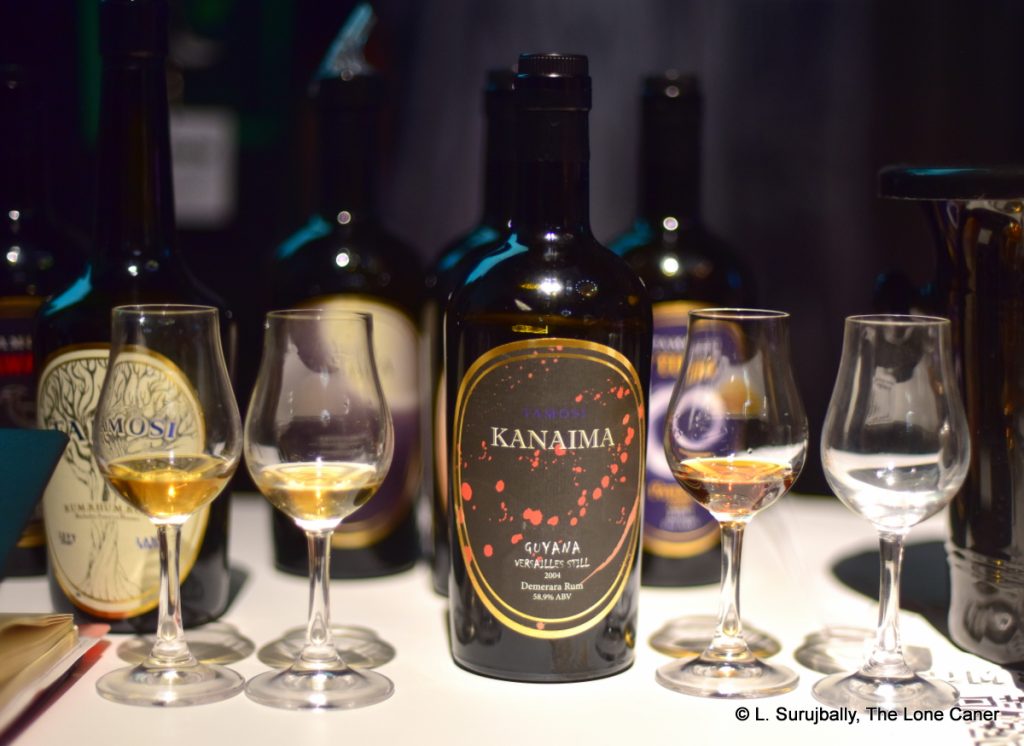 Memories are short in this day and age of always-on ADD infotainment, yet I remember quite clearly the short and sharp social media posts that erupted over the naming of Tamosi’s first rum “Kanaima,” which was considered disrespectful appropriation and misnaming (at the very least) of an Amerindian term by a commercial entity (see backgrounder below this review for an expanded discussion of the matter).
Memories are short in this day and age of always-on ADD infotainment, yet I remember quite clearly the short and sharp social media posts that erupted over the naming of Tamosi’s first rum “Kanaima,” which was considered disrespectful appropriation and misnaming (at the very least) of an Amerindian term by a commercial entity (see backgrounder below this review for an expanded discussion of the matter).
For those who are not familiar with the term “kanaima”, it variously refers to a spiritual force of the jungle which can be tapped into, a spirit being, or (in my own favourite) the name of an Amerindian deity, whose most famous manifestation may be A.J. Seymour’s wonderful narrative poem “The Legend of Kaieteur” which I highly recommend everyone read, and which starts:
Now Makonaima the Great Spirit dwelt
In the huge mountain rock that throbbed and felt
The swift black waters of Potaro’s race
Pause on the lip, commit themselves to space
And dive the half mile to the rocks beneath.
Black were the rocks with sharp and angry teeth
And on those teeth the eager waters died
Lost their black body, and up the mountainside
Above the gorge that seethed and foamed and hissed
Rose, resurrected, as lovely mist.
Well, that’s probably more than what you wanted (the poem is much longer1) You came here for a rum review, not an extended lesson in Guyanese verse or a treatise on amerindian spiritual naming sources. Still it says something about the word, and to this day “kanaima” (small k) is often used when speaking in the bush about spirits, especially shape-shifting were-jaguars, which are expanded on in the about page for the rum.
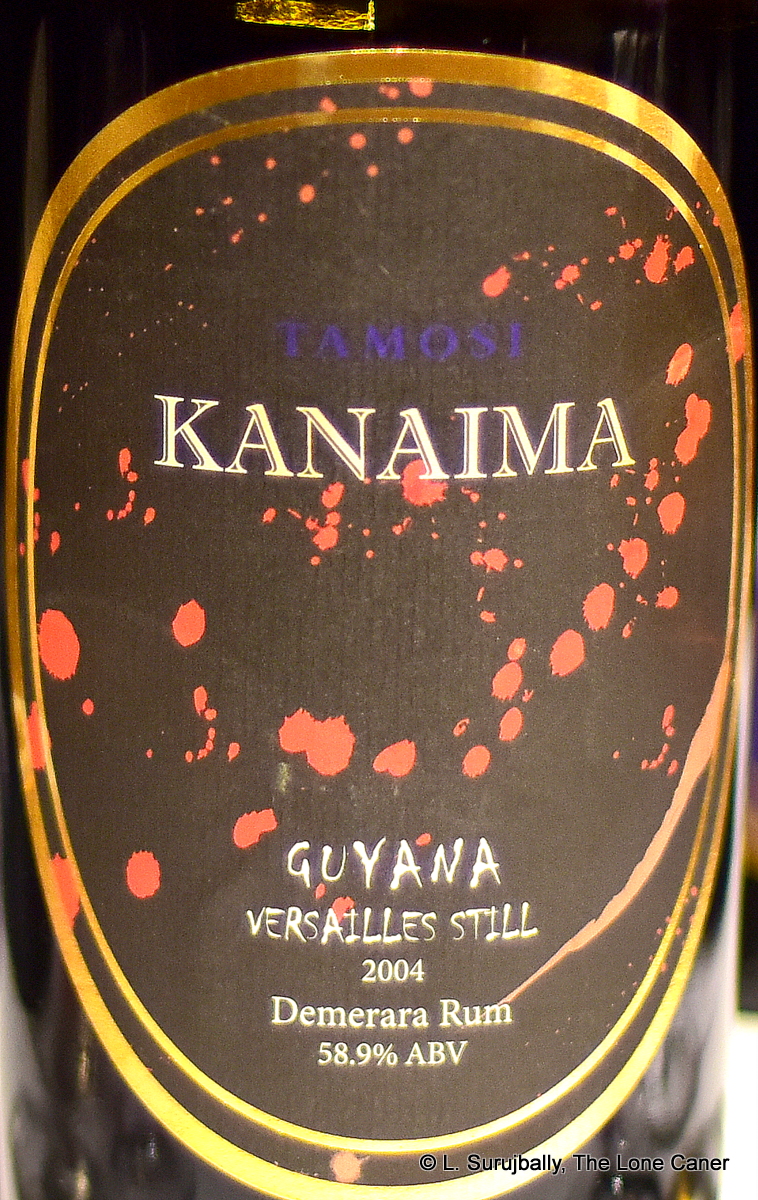 Introduction and naming aside, here are the bare stats: it’s a continentally aged 16 year old Guyanese Versailles wooden pot still rum from 2004, aged in ex-bourbon casks and bottled at 58.9%. Some caramel was added for colouring, and the company founded by UK-based Guyanese Benjamin Boothe has continued with its releases and naming practises ever since. Like Nobilis or Rum Artesanal, two other small indies founded at about the same time, Tamosi has raised the game of limited releases with high-quality selections that have kept its reputation polished to a shine.
Introduction and naming aside, here are the bare stats: it’s a continentally aged 16 year old Guyanese Versailles wooden pot still rum from 2004, aged in ex-bourbon casks and bottled at 58.9%. Some caramel was added for colouring, and the company founded by UK-based Guyanese Benjamin Boothe has continued with its releases and naming practises ever since. Like Nobilis or Rum Artesanal, two other small indies founded at about the same time, Tamosi has raised the game of limited releases with high-quality selections that have kept its reputation polished to a shine.
Tasting notes are about what one would expect if one was into Guyanese rums generally, and the wooden heritage stills specifically. The nose, for example, is so Versailles-like, it squeaks; it’s rare that I get an aroma so clearly identifiable with and relatable to that still, because usually there are aspects of the other two stills hovering around that cloud the analysis. Here it is woody, bright, pure, clean, sparkling, tannic, and chock full of sawdust and wet wooden shavings freshly shaved off an uncut piece of lumber. There’s licorice, leather, tannins, cider, grapes, salt, a few dark fruits, cinnamon and bitter black tea leavened with just a smidge of condensed milk and cardamom.
The palate is rich and deep: the proof really helps here – stronger would not work nearly as well. It’s slightly bitter to taste, with mauby, cinnamon and coffee grounds, plus a touch of almonds and molasses. Once it calms down, it gets better, channelling the same bush tea the nose suggested, a little licorice and a few dark fruits. The overwhelming impression one is left with is not fruitiness but rather aromatic tobaccos and newly-sawn lumber, and that it works as well as it does is impressive. One false note, one element more than another and the whole carefully balanced edifice would shatter and collapse. But somehow that never happens, and with a long, crisp, dark finish that closes things off — licorice, salt caramel, black grapes, molasses, hot sweet tea, cider and brine — it ends by being a wonderfully well-assembled VSG rum and one I enjoyed thoroughly.
I’ve often thought that it takes real skill to bring a Versailles-still rum to its full potential, and there are a lot of hit and miss expressions out there. Ten years ago something of this calibre would likely have made a bigger splash than it did, even without the attendant publicity surrounding the name. Because to get a VSG marque rum this good is a rarity – PM and Enmore and Diamond and even Uitvlugt tend to have slightly higher reputations and more easily approachable profiles, while Versailles…well, not so much. And of course, now, a few years on, the Kanaima has faded from sight somewhat as newer indies and newer releases and newer halo rums come to the fore and replace it.
But I think the rum is some kind of wonderful on its own terms, and shouldn’t be overlooked or left to rust. It’s on the far side of raw, still possessing some attitude, complex to a fault and recognizable Guyanese, while being tamed just enough by time and barrel action to be enjoyable. It’s original and deeply rough and tasty as all get out — and while I can’t quite go as far as Marius of Single Cask Rum when he said it was, “the best VSG to come out of DDL to date,” I think it’s for sure one of the top expressions of the marque and from the still to ever make it to the wider public.
(#971)(86/100) ⭐⭐⭐⭐
As noted, Benjamin Boothe, a first generation Guyanese immigrant to Britain (he lives in Amsterdam now), started the indie brand called Tamosi in 2020, named after aspects of Carib and Amerindian cosmology. Because his ethnic and cultural background is also West Indian, he hit on the idea of drawing attention to, and honouring, the names of local deities and spirits from indigenous and imported folklore, and named his first rum “Kanaima” explaining the choice and its background both on the bottle label and on the company website. It is clear that this was no quickie commercial marketing scheme, but something deeply felt – the level of research Mr. Boothe brought to the table was not inconsiderable (which is something a lot of other indies which claim to honour historical heritage don’t really do beyond the superficial).
You will recall that this was at the height of several interlocking and vicious social and cultural rum wars: the Barbados GI, the j’ouvert rum from Michael B. Jordan, Velier’s imbroglio with the extolling of Haiti’s undeveloped pastoralism, the “Plantation” and “Esclavo“ names, BLM, and all sorts of posts coming out almost daily about racism, diversity, gender bias, appropriation and so on.
So it was probably no surprise that almost immediately people came out of the social media woodwork to accuse him of cultural insensitivity towards indigenous religious beliefs (though few if any of the commentators were indigenous themselves). Academics with purportedly years of research into the matter challenged his assertions. Comments came thick and fast, claiming it was historically incorrect, and rank neo-colonialist cultural appropriation if not outright theft by some guy not even from the region and as usual, some of it became quite ugly. Boothe engaged with his detractors and explained his rationale, which boiled down to this: too many historical callouts in the rum world’s marketing were either superficial or limited in focus, and his own very extensive researches had shown there was quite a bit more to early sugar and rum production that involved other ethnic groups and their interactions, and this was one way to provide more information and background to that aspect of things. To my knowledge not one of his interlocutors conceded he had a point, which to my mind says rather more about them than the argument they were trying to make.
Moreover, not only did Boothe have a West Indian heritage himself, his research was no slapdash cut-and-paste shallow excerpt from a primary school text or someone else’s online post, but a close reading of many historical tomes, academic papers and primary sources to which he had dedicated much time and effort. In other words, the naming convention chosen was being done with respect and knowledge, by someone who had a cultural connection to the term much closer than, say, that of Michael B. Jordan, whose tactless trademarking of j’ouvert to name his rum at around the same time, without a smidgen of relationship to the term, also raised hackles.
However, Boothe stuck to his guns; he defended his choices, refused to alter his company’s or his rums’ names, and as usual, memories faded, the world moved on and Tamosi is a fact of life now (as are all other bottles issued under the brand, which continue the theme of being named after local spirits and deities of the country of origin). With one exception, nobody has raised the issue since that time – unlike, say, Plantation or Esclavo business, which reliably pops up for a question and a mention on reddit or Facebook at least once every few months. And there the matter lies.
